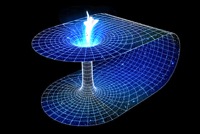Wormhole
Definitions
- 1: a hole or passage burrowed by a worm
- 2: a hypothetical structure of space-time envisioned as a long thin tunnel connecting points that are separated in space and time
Description
A wormhole or Einstein-Rosen Bridge is a hypothetical topological feature that would fundamentally be a shortcut connecting two separate points in spacetime. A wormhole, in theory, might be able to connect extremely far distances such as a billion light years or more, short distances such as a few feet, different universes, and different points in time. A wormhole is much like a tunnel with two ends, each at separate points in spacetime.
The Einstein–Rosen bridge was discovered by Ludwig Flamm in 1916, a few months after Schwarzschild published his solution, and was rediscovered (although it is hard to imagine that Einstein had not seen Flamm's paper when it came out) by Albert Einstein and his colleague Nathan Rosen, who published their result in 1935. However, in 1962, John A. Wheeler and Robert W. Fuller published a paper showing that this type of wormhole is unstable if it connects two parts of the same universe, and that it will pinch off too quickly for light (or any particle moving slower than light) that falls in from one exterior region to make it to the other exterior region.
Although Schwarzschild wormholes are not traversable in both directions, their existence inspired Kip Thorne to imagine traversable wormholes created by holding the "throat" of a Schwarzschild wormhole open with exotic matter (material that has negative mass/energy).
A possible resolution to the paradoxes resulting from wormhole-enabled time travel rests on the many-worlds interpretation of quantum mechanics. In 1991 David Deutsch showed that quantum theory is fully consistent (in the sense that the so-called density matrix can be made free of discontinuities) in spacetimes with closed timelike curves. However, later it was shown that such model of closed timelike curve can have internal inconsistencies as it will lead to strange phenomena like distinguishing non orthogonal quantum states and distinguishing proper and improper mixture. Accordingly, the destructive positive feedback loop of virtual particles circulating through a wormhole time machine, a result indicated by semi-classical calculations, is averted. A particle returning from the future does not return to its universe of origination but to a parallel universe. This suggests that a wormhole time machine with an exceedingly short time jump is a theoretical bridge between contemporaneous parallel universes.
Because a wormhole time-machine introduces a type of nonlinearity into quantum theory, this sort of communication between parallel universes is consistent with Joseph Polchinski’s discovery of an "Everett phone" in Steven Weinberg’s formulation of nonlinear quantum mechanics. Such a possibility is depicted in the science-fiction 2014 movie Interstellar.[1]
